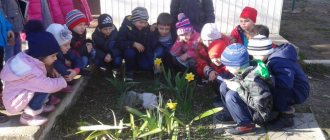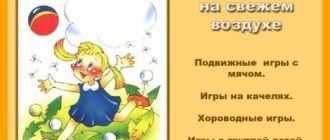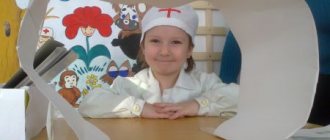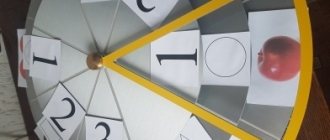Summer games using crayons
Summer Game Chalk Snail
Age : 3-7 years.
Number of players: 1-3.
What develops : memory, visual and motor coordination, eye, dexterity.
What you will need : crayons.
Description : Draw hopscotch on the asphalt in the shape of a snail (a spiral-twisted path, lined into squares). Inside you can write numbers, letters, days of the week, names of planets, etc. depending on what needs to be learned. The child jumps across the squares on two legs forward and backward. You can make the game more difficult by asking your child to jump on one leg. If there is more than one participant, then the children jump in turns.
Summer game using chalk Hopscotch
Age : 3-7 years.
Number of players: 3-5.
What develops : visual and motor coordination, eye, dexterity.
What you will need : crayons, small stones.
Description : Draw the usual classics on the asphalt. The player throws a stone with his hand (or foot) onto the square with numbers and jumps on it with both feet, then moves the stone to the next square and jumps onto it. The stone must not stop on the line. Children jump in turns, the one who can complete the hopscotch first (or the one who completes the hopscotch in the least number of movements) wins.
Unusual classics
Age : 3-5 years.
Number of players: 1-2.
What develops : memory, visual and motor coordination, eye, dexterity.
What you will need : crayons.
Description : Draw the usual classics on the asphalt, but draw geometric shapes inside the squares. Possible task options: jump on figures of a certain shape, for example, triangles; jump only on quadrangles (rhombus, square, rectangle, etc.); jump only on those figures that the leader calls; jump and name the piece yourself; jump on figures without corners and more.
Outdoor game Labyrinth
Age : 3-5 years.
Number of players: 3-5.
What develops : visual and motor coordination, eye, dexterity.
What you will need : crayons.
Description : Draw a labyrinth on the asphalt (the shape can be changed depending on the age and skills of the child). You need to run through the maze without stepping on the lines, trying to find a way out in less time. You can play tag, blind man's buff, etc.
Summer game Hit the figure
Age : 3-5 years.
Number of players : 5 or more.
What develops : visual and motor coordination, eye, dexterity, accuracy, ability to throw objects at a target.
What you will need : crayons, pebbles (cones, short sticks).
Description : Draw any shapes (circle, square), there should be as many of them as there are participants. These will be targets. Each player needs to hit his piece with a cone (stick, pebble), and the objects should not be on the line. The one with the most items inside the target wins.
Outdoor games in summer
Outdoor game for little ones Naughty chickens
Age : 2-3 years.
Number of players: 3-5.
What develops : control of emotions and impulsiveness (helps overcome negativism, stubbornness during the three-year crisis).
Description:
An adult speaks on behalf of the mother chicken:
Naughty chickens don’t want to listen to their mother. Stomp your feet, (children answer: “No, no, no”) Clap your hands, (children answer: “No, no, no”) Nod your head, (children answer: “No, no, no”) Play with me. (children answer: “No, no, no”)
An adult shakes his finger: Oh, how mischievous, how naughty!
Don’t stomp your feet, (children answer: “We will, we will, we will” and stomp their feet) Don’t clap your hands, (children answer: “We will, we will, we will” and clap their hands) Don’t nod your head, (children answer: “We will, we will , we will” and nod their heads) Don’t play with me. (children answer: “We will, we will, we will” and run around the adult)
Oh, how naughty, how naughty!
Summer game Rain
Age : 3-5 years.
Number of players : 2 or more.
What develops : motor activity, the ability to control your body, the ability to obey simple rules of the game.
Description : An adult draws two small circles (or more depending on the number of players) on the ground (or chalk on the asphalt) - a house for himself and the child. If an adult says: “Sunny,” then he and the child run, play, and have fun near the houses. When you hear the word “Rain,” you need to quickly run into the house, squat down, crossing your arms above your head in the form of a roof.
Outdoor game Huge dog
Age : 3-4 years.
Number of players : 5 or more.
What develops : endurance, the ability to overcome one’s timidity and follow some basic rules.
Description : An adult draws a circle on the ground - this is a house for a huge dog. At a distance of several steps from him, a line is drawn that the children must reach. From this line, at a distance of 15-20 steps, a second line is drawn, where the children will escape from the dog. One of the children is assigned the role of a huge dog - he goes to his house and waits for the children to come to him. The adult brings the children to the edge of their house and lines them up. First, the adult herself leads the children, setting the direction and pace of movement, and says the following words, which all the children repeat with her:
Here sits a huge dog, with his nose buried in his paws. Quietly, quietly he sits, either dozing or sleeping. Let's go up to him, wake him up and see if something happens!?...
Under this text, all the children, holding hands, creep up to the line next to the dog’s house. On the last two lines they reach out and touch him. The dog should not move at this time: sitting with his eyes closed, he allows himself to be stroked. Suddenly, unexpectedly for the children, the dog opens his eyes and barks, and the kids run away into their house (beyond the line). The dog runs after the children, barks at them, and when everyone runs away over the line, he returns to his house. Each child chosen for this role performs it no more than two times, after which a new dog is chosen.
Rules that are not so easy for three-year-olds to follow: do not touch the dog until the text ends; the dog does not move and does not open his eyes until he is touched; You can run to your house and save yourself only after the dog barks.
Outdoor game Sparrows and cars
Age : 3-4 years.
Number of players : 7 or more.
What develops : endurance, the ability to follow some basic rules, slow down your impulsive motor activity, act strictly on a signal.
Description : An adult outlines an area on the ground where sparrows can fly and jump (the space should be large enough). Along the edges of the site he draws houses for the sparrows (circles, squares, etc.). This is where they will fly when the car starts moving. The adult explains that in their house the sparrows are not afraid of cars, and as soon as the car passes, they can jump and fly again.
First, an adult takes on the role of the car, showing how it drives and honks. Having made the appropriate movements, she says: “Fly, sparrows!” Children run out to the middle of the playground, pretending to see sparrows flying and jumping. Suddenly a horn sounds, and the car drives across the site again, and the sparrows run away to their houses, where they escape from the car. The teacher “drives” from end to end along the playground a couple of times, returns to her station and gives the signal: “Fly, sparrows!” This is repeated several times. Then several children are selected to represent cars. Now the adult gives only a verbal signal when cars should act and when sparrows should act (for example, a horn can be a signal for cars, and a chirp can be a signal for sparrows). When repeating the game, children can change roles.
Summer game Brave Mice
Age : 3-4 years.
Number of players : 7 or more.
What develops : endurance, the formation of self-control (in strict adherence to rules), the ability to overcome one’s timidity.
Description : Two lines are drawn at a distance of approximately 20 steps and a house for the cat is drawn. An adult chooses 5-6 people to play the role of mice, and one to play the role of a cat. The mice stand at the line, and the cat takes its place in the house. With the beginning of the poem S.Ya. Marshak, which is pronounced by an adult together with all the children, the mice take several steps towards the second line:
One day the mice came out to see what time it was. One-two-three-four - The mice pulled the weights... (Having stopped approximately in the middle of the space between the two lines, the mice make a movement with their hands, as if they were pulling the weights). Suddenly there was a terrible ringing sound! (...long pause...) The mice ran away!
With the last words, which are pronounced sharply and unexpectedly, the mice run away, and the cat catches them. Mice can escape from the cat behind any line, moving either backwards or forwards (of their choice). The cat can catch them only in the space between two lines. Only those mice that the cat touched are considered caught (you cannot grab or drag children).
Game From Stick to Stick
Age : 4-7 years.
Number of players : 3 or more.
What develops : endurance, strength.
Description : They measure the distance using sticks and run “from stick to stick” all together, at an average pace that is feasible for everyone. When they reached it, they stopped, turned around and ran back. Do this several times. Whoever is tired is out. The last one standing wins
An outdoor game for the summer. Let's catch up in a circle.
Age : 4-7 years.
Number of players : 5 or more.
What develops : endurance, strength, sense of rhythm.
Description : Draw a circle (size depending on the number of players) - this is the running distance. Position yourself along it at an equal distance from each other. At the signal, everyone starts running at the same time. Someone runs faster and catches up with the person running ahead. The one who is caught must leave the race. Whoever is left wins.
Outdoor game in the summer Along the ribbon
Age : 4-7 years.
Number of players : 5 or more.
What develops : endurance, strength, eye, agility.
Description : Several parallel straight lines are drawn on the ground (the number depends on the number of players), marking the distance (50-60 meters). The players stand on their lines and, at the start signal, run the race - it is important not only to come first, but also to run the distance “like a ribbon” - so that the tracks always fall on the drawn straight line (this will be easier for those who run, raising their knees high, rather than dragging your feet).
Game Tulle wolves-sheep
Age : 4-7 years.
Number of players : 7 or more.
What develops : endurance, strength, eye, agility, the ability to dodge and quickly change direction while running.
Description : Use a drawing or improvised means to limit the playing area (it should be spacious). One player is a shepherd, two are wolves, the rest (at least four) are sheep. Sheep need to escape from wolves. Wolves are chasing sheep. And the shepherd, while protecting the sheep, chases the wolves. The shepherd wins if he kills both wolves (the party of sheep wins along with him). The wolves will win if they manage to kill all the sheep.
Game for summer Burners
Age : 4-7 years.
Number of players : 7 or more.
What develops : endurance, agility, attention.
Description : The players stand in pairs, holding hands, one pair after another, and in front of everyone is one who, by lot, got to burn. He can't turn back. Those standing in the last pair in the count “one, two, three” separate their hands, run forward and try to connect again, running around the driver-burning one on the left, the other on the right. The same one pursues those running, and if he manages to catch someone, then he becomes the first pair with the one caught, and the one who is left alone is left to burn. If the one who was burning did not manage to catch anyone, then the same pair stands in front of the other pairs, and he burns again.
Outdoor game Lifesaver
Age : 4-7 years.
Number of players : 5 or more.
What develops : endurance, agility, attention, speed.
Description: The driver stands up to the wall, takes a stick, knocks on the wall and says: “The stick came, it didn’t find anyone, whoever it finds first will go for the stick.” After these words, he looks for the players, noticing someone, quickly runs, takes a wand, knocks on the wall and says: “I found a lifesaver... (name).” If the player who was found reaches the stick before the driver, he quickly takes the stick and with the words “Wand, help me out!” knocks and throws it as far as possible, while the driver is looking for her - hiding.







